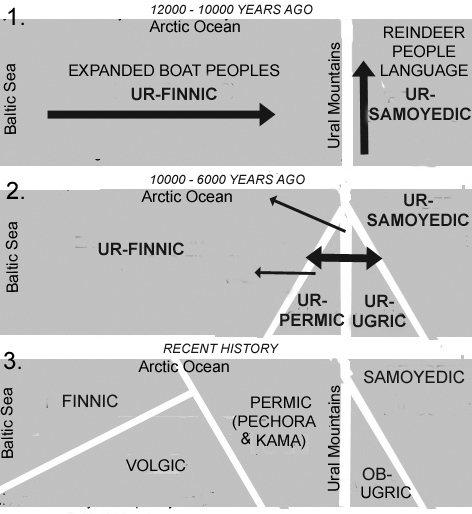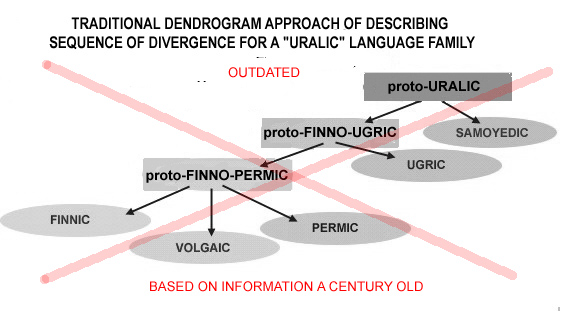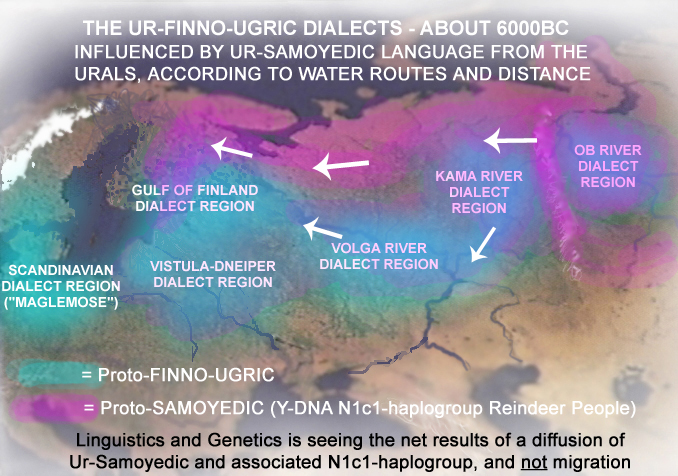
supplementary articles

LANGUAGE IN UIRALA
THE TRADITIONAL "URALIC
LANGUAGE FAMILY" IS A NAIVE 19th CENTURY CONCEPT
Synopsis
In the last half century, analysis of
the surviving indigenous languages of northwest Eurasia has lead to
language-based speculation of how these languages are related to
one another and the
results arranged in a tree diagram (a dendrogram). The reconstruction
of the past from surviving languages is about as valid as predicting
future events from the use of astrology. Both linguistics and astrology
have roots in reality, but they then pretend to predict or reconstruct
more than is possible.
The
Traditional "Uralic Language Family" is now over a century old and
completely outdated, and other sciences should not even make reference
to it.
Over a century ago, very little was known about the
past in northern Europe. Knowledge about an Ice Age was vague. Little
was known about how humans responded to the climate warming that
brought an end to the Ice Age. Nothing was known about the timing of
the warming. It was not known that when the climate warmed to how it is
today, glaciers still covered the Scandinavian Peninsula and were
flooding lands with glacial seas and the regions south of the swollen
Baltic Sea were also still depressed from the former weight of
glaciers, producing a very flooded landscape....How did all these
events lead to changes in way of life, the population explosions due to
climate warming in the north, the expanding of animal and human
populations, how Asian reindeer peoples survived,....and so on?
Over a century ago, the world was excited by the
discovery that species form family trees and that one can link modern
species to past species whose fossilized bones are found in the ground.
The scientific world was family-tree-obsessed. Thus when a German
linguist proposed it was possible to reconstruct the descent of modern
languages with some similarities to each other in terms of a similar
family tree, adding some hypothetical parent languages, then the
linguistic world went crazy. Finding an array of surviving languages in
the remote parts of northwest Eurasia with assorted words in common,
they were fired up to discover a language family tree.
A famly tree assumes there was a single parent
language which produced daughter languages. In order for new languages
to develop, it was necessary for them to drift apart from each other
and their parent. If a daughter language remained in contact with their
parent language, then no new language was created. Thus the very
premise that there had been a continuous evolution of new
languages from an original parent language is not necessarily true. If
the speakers of a language are widely spread out and constantly making
contact with each other as a result of being highly mobile, then all
the daughter breakaways from an original parent tribe, will
continue to speak the same language and culture of the parent. What
changed was simply that the population grew, one founding tribe became
numerous tribes, and the original language became spread over a wide
area. And this was the case of the expansion of the boat peoples
that emerged beneath the glaciers.
So when does an original language cease to simply
produce more of the same language, and begin to produce new languages.
The linguistic methodology created a century ago needs the original
language - which can grow to cover a vast population - to start
diverging and create branches that survive to the modern day.
Obviously, the further away the daughter tribes were located the less
contact there was with the source language and dialects of sister
languages.
It is generally understood in linguistics, that when
daughter tribes stop communicating with each other or the parent, the
languages of the daughter tribes will begin to naturally drift since
arbitrary changes will be corrected any longer. The linguists who were
driving for a family tree, needed to find the separation occurring that
would lead to divergence between daughter peoples in one location
versus another.
The 19th century linguists had no idea about the actual physical
evolution of northwest Eurasia as the Ice Age retreated. All they had
to work with was standard theories pertaining to settled peoples who,
when breaking away from a parent, did not have to travel very far, in
order to become sufficiently separated from the parent, for cultural
and linguistic divergence to occur. Otherwise, they only had some
linguistic and anthropological data. There was even ignorance about the
behaviour of "primitive" northern nomadic people, information that was
readily available from studied of northern North American boat peoples
in a similar post-glacial flooded environment - the peoples
collectively called the "Algonquians" (people popularly known for their
birch-bark canoes.)
Thus the linguistic theory invented and promoted
since the late 1800's was a quite arbitrary and artificial construct
that proposed FInnic cultures migrated in stages from the Urals region
treating all peoples as if they were settled peoples confined to small
areas similar to recent centuries. Only a knowledge of the Algonquian
peoples covering the east half of what is now Canada, will show that
originally there was a single language covering as much as 4,000 km
(from Scandinavia to the Urals), divided dialectically according to
water systems. Had the early "Uralic" linguists known this in the
beginning, they would have immediately seen that for a long time the
daughter languages were only dialects of the parent language, and the
development of branches did not begin until the far ranging nomadic way
of life with boats began ending - when as a result of less long
distance gatherings of communciations, the dialects became more extreme
and divided into strong dialects in the different water systems -
Baltic, Volga, Kama/Pechora, Ob - and eventually with settlement the
strong dialects became languages.
Figure 1
The century-old now outdated theory
Outdated
theory of "Uralic" languages created when very little was known about
the past from other sciences, and even false application of a
methodology developed for southern langauges
DO NOT USE THIS THEORY TO 'PROVE' OTHER THEORIES
The real
events as revealed by what we know today, and how it impacted languages
of northwest Eurasia
What does this mean?
It means that in reality, there was an original
language for the boat peoples - the language at the south and east
Baltic (archeologically the "Maglemose" and "Kunda" cultures). With
climate warming and growth in populations of all life, these people
produced new tribes, which produced new tribes, etc, with an expansion
eastward as the tribes exploited the environment uninhabited by any
other peoples - until they came close to the Urals.
Note how I said above, that if daughter tribes did
not break from the parent or sister tribes, then the language of the
original parent would continue, and that the comparative linguistic
methodology would not detect a language until there was branching. If
the whole northwest Eurasian region produced more and more daughter
tribes that did not produce any new branch languages surviving to the
modern day, then linguistic methodology would not be able to
reconstruct a past going back further than when the branching began. As
a result the linguists using the comparative methodology, recieved from
linguistic data alone, the illustion that the original parent language
began around 4,000-6,000 years ago. That is only an illustion, because
with far ranging nomadic peoples, daughter tribes did not diverge and
cause branched that modern linguistics could identify and analyse.
Thus the naive linguists, including those who still
worship the 19th century theory today, saw a new language arising
around 4,000-6,000 years ago, when in reality there was a widely
distributed language covering the whole area, with daughter tribes
continuing to speak the same dialect. (Similarly to the Algonquian
languages with their dialectic divergence only according to water
system boudaries reducing boat crossings from one water system to
another.)
Therefore the greatest mistake made by the
traditional "Uralic Languages" linguists was to assume humans many
thousands of years ago were as settled as in recent centuries, instead
of being highly nomadic and far ranging and maintaining a base language
over a vast area. This can be thought in terms of a "broad origin
theory". The concept that you can have repeated births of daughter
tribes, with no resulting new languages, through many thousands of
years, was and still is new to linguistics. If this had been understood
in the 19th century, then linguists would have realized that the
"Finnic", "Volgaic", "Permic" (Kama and Pechora Rivers) , and
"Ob-Ugric" (Ob River) groupings of languages largely developed from the
reduction of seasonally nomadic way of life and contraction of range of
contact with neighbours. There was no migration-separation, but simply
dialectic divergence from degrees of settling down, becoming most
contracted with farming settlements.
Reindeer people, a complicating factor
The original 19th century theory, wanted to include
the reindeer people, the Samoyeds, in the family tree. Therefore
they chose their hypothetical founding language - the "Uralic parent" -
so that in its first branching was between the boat-using
hunter-gatherers, and the reindeer-oriented Samoyeds. The only
basis for doing so was perhaps finding some similar words. But as I
argue, these words shared by the "Finno-Ugric" and "Samoyedic"
languages could simply be borrowings arising from contacts. If these
borrowings occurred very early, such as 10,000 years ago, they would
have become completely internalized in the languages, with no way for
linguists to distinguish between early borrowing or later divergence
from a common parent.
For this reason, my theory, that replaces the
traditional "Uralic Languages" theory created a century ago, begins
with TWO source languages - those of the "Ur-Finnic" boat peoples, and
those of the "Ur-Samoyedic" reindeer peoples. Aspects of each language
diffused into the other language, but did so around 10,000 years ago
(when archeology and population genetics suggests the contacts began)
and became completely internalized, giving the illusion of both having
a common parent. Is it possible to consider a common reindeer people
parent since the boat peoples arose in south Scandinavia from
north European reindeer people a couple millenia earlier? The
answer is probably not, since all European reindeer peoples became
"Kunda" boat peoples, and population genetics reveals the migration of
reindeer people of Asian origins up the Ural Mountains. Population
genetics thus, suggests that around 10,000 years ago there were two
different languages - the Asian one of the Asian reindeer people who
became Asian arctic peoples with mongoloid appearance, the European one
of northern Europe peoples of boat-people origins. That was followed by
diffusion of aspects from one to the other, according to amounts and
patterns of contact.
This contact between the two languages, if it
occurred since around 10,000 years ago, means it occurred before the
arctic to the north of the Urals was glacier free. This is why a
portion of the Nenets Samoyeds are thought to have migrated north at
some point. The reason is simple - they had to wait for the glacier and
the glacial sea from the melting, to subside. When it did subside there
was migration both northward and west along the arctic coast to Finland.
The complicating factor thus, arose from the entry
of Asian reindeer people concurrent with the arrival of boat peoples
from the west, in the vicinity of the Ural Mountains.
Conclusion:
the two origins theory
If linguists had known of the Asian reindeer people,
they would not have put the origins of their language family at the
roots of both the boat people (Finno-Ugrians) and reindeer people
(Samoyeds), but saw contacts that lead to aspects of the one language
getting adopted into the other so long ago that they became
internalized - so that the first step of a divergence rather than
convergence, was false. And then, regardless of the diffusion of
Samoyedic elements into the boat peoples language, there was also the
gradual dialectic divergence as the widely distributed boat people
language became increasingly broken up and diverged dialectically from
the ending of the original far ranging way of life.
In addition, linguists would have paid much
attention to the Turkish characteristics in Samoyedic languages, and
linked it with the Asia reindeer people origins in the vicinity of
Turkish languages.
Figure 2,3
The true story of the "Uralic" (I
suggest "Euralic") Languages
The
red suggests diffusion of both linguistic elements and genetic elements
from the Asian reindeer peoples into the the language and genetics of
the boat peoples (blue) and vice versa, according to mixing at
locations of sustained contact The following graphics shows
sequence of events, based on the two origins and mixing, replacing the
original single-origins theory which only makes sense if we say that
they all originated from west-central Eurasian reindeer peoples.

The
above set of diagrams attempts to describe the two-origins theory with
triangles representing northwest Eurasia.
1.
12,000 onward: Boat peoples from Europe expand during climate warming
(this is proven by archeology over the past over half century) Asian
reindeer people with mongoloid characteristics migrate north with the
reindeer herds who need tundra and lichens of cold climates.
2.
There is contact between the the boat peoples and reindeer peoples that
cause aspects of culture and language from each side diffuse into the
other - so early that it can be mistakened for divergence from a common
parent. (Suggested by arrows)
3.
By about 5,000 years ago, the internal dialectic divergence is so weak
it has not yet caused clear branching that linguistics can
observe via comparative linguistics. But from about 5,000 years ago in
many locations the original nomadic boat peoples become less nomadic
and settled down, causing the dialectic divergence to intensify,
leading to many languages, that can be grouped as related languages
within the major water basins.
FURTHER
INFORMATION
author: A.Paabo, Box 478,
Apsley, Ont., Canada
2018 (c) A. Pääbo.






